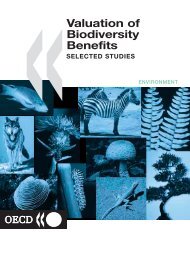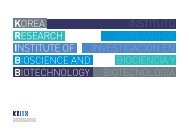Untitled
Untitled
Untitled
- No tags were found...
Create successful ePaper yourself
Turn your PDF publications into a flip-book with our unique Google optimized e-Paper software.
Division of Bioconvergence TechnologyBioNanotechnologyResearch CenterACHIEVEMENTSDevelopment of a new palm-sized surface plasmon resonance (SPR) biosensorA novel surface plasmon resonance (SPR) sensing scheme was devised to develop apalm-sized SPR biosensor device. This provides for a portable POCT SPR sensor devicewhich enables label-free and real-time analyses. This method also eliminates imagequality deterioration originating from the coherency of the laser illumination source.The results of a series of tests confirmed the practicality of sensor for the on-sitedetection of a variety of substances in biology, diagnosis, the environment, and defense.RESEARCHERSBong Hyun Chung chungbh@kribb.re.krBionanotechnologySmart biochips & biomolecular process engineeringMyung Kyu Lee mklee@kribb.re.krBiochemistry & immunologySang Jeon Chung sjchung@kribb.re.krChemical biology & biointerfacing technologyChang-Soo Lee cslee@kribb.re.krNanotechnology, molecular self-assemblyIm Sik Chung cis123@kribb.re.krNano-polymer chemistryMoon Il Kim kimm@kribb.re.krMolecular biology, bioelectronicsYongwon Jung ywjung@kribb.re.krBio-analysis, bio-interfacingYoonkyung Kim ykim@kribb.re.krSupramolecular Bioorganic Chemistry, NanomedicineHyejung Mok hjmok@kribb.re.krDrug delivery system, biomedical imaging and diagnosticsJin Young Jeong jyjeong@kribb.re.krNanomaterials, BionanomedicineRESEARCH AREASProtein chipsDevelopment of platform technologies to construct a newgeneration of protein chips, whose detection systems arefree of fluorescence and radioisotopesCreation of protein chips with bio-content that can beemployed in disease diagnosis and in highthroughput screening of potential pharmaceuticalsNanomaterials and BioimagingConjugation of inorganic materials, such as metals andmagnetic nano-particles, to various organic molecules inorder to investigate the characteristics of proteins andto develop new drugsNanobiosensorsDevelopment of platform technologies to establish andto economically implement biosensors in early diseasediagnosisLabel-free, ultrasensitive nanobiosensingBio-content and hardware interfacingDisease diagnosis biomarker design and productionMobile Life Care SystemDevelopment of technology for Mobile Life Care Systems,enabling portable healthcare, by combining IT withbiochips and biosensor technologyDirector Bong Hyun ChungT + 82-42-860-4442F + 82-42-860-8594E chungbh@kribb.re.krPerfluorodecalin/[InGaP/ZnS quantum dots] nanoemulsions as 19F MR/optical imagingnanoprobes for the labeling of phagocytic and nonphagocytic immune cells.We developed the bimodal imaging contrast agent, perfluorodecalin (PFD)/[InGaP/ZnSquantum dots (QDs)] composite nanoemulsions. (19)F molecules in the PFD/[InGaP/ZnSQDs] nanoemulsions provide a (19)F-based MR imaging capability, while fluorescent QDsdispersed in PFD nanodroplets provide an optical imaging modality. These bimodalimaging contrast agents can be delivered easily into both phagocytic and nonphagocyticimmune cells. Internalization of multifunctional PFD/[InGaP/ZnS QDs] nanoemulsions intoimmunotherapeutic cells permits the labeled cells to be imaged by both magneticresonance and fluorescence imaging with little effect on cell viability and function. Theresults of our study highlight the potential of PFD/[InGaP/ZnS QDs] nanoemulsion as abimodal imaging nanoprobe for molecular imaging in immune cell-based cancertherapies.Fabrication of a structure-specific RNA binder for array detection of label-freemicroRNAA novel structure-specific RNA-binding protein was designed to stably and specificallybind to surface-bound microRNAs. By acting like an antibody, this RNA binder enabled theuniversal detection of hybridized microRNAs on array surfaces (see picture) without anyenzymatic amplification or labeling reactions.SELECTED PUBLICATIONSBong Hyun Chung (Corresponding) Biomaterials. 31(18):4964-71.Perfluorodecalin/[InGaP/ZnS quantum dots] nanoemulsions as 19 F MR/optical imagingnanoprobes for the labeling of phagocytic and nonphagocytic immune cellsYongwon Jung (Corresponding) Angew Chem Int Ed Engl. 49(46):8662-5.Fabrication of a structure-specific RNA binder for array detection of label-free microRNABong Hyun Chung (Corresponding) Chem Commun (Camb). 46(19):3315-7.Label-free and naked eye detection of PNA/DNA hybridization using enhancement of goldnanoparticlesSang Jeon Chung (Co-corresponding) Chemistry. 16(18):5297-300.An iminocoumarin-based fluorescent probe for the selective detection of dual-specificprotein tyrosine phosphatasesBong Hyun Chung (Corresponding) J Phys Chem C. 114(30):12976-81.Synthesis and characterization of various-shaped C60 microcrystals using alcoholsas antisolventsOur research center is involved in the development of nano-biochips, nano-biosensors and nano-biomaterials based on theexploitation and utilization of bio-content. By conducting integrated research in the fields of biotechnology (BT),nanotechnology (NT) and information technology (IT), our goal is to develop tools to facilitate new drug discovery as well asnew technologies for the diagnosis and treatment of diseases, which will contribute to the creation of new businessesand realize our dream of prolonging human life.Bong Hyun Chung (Corresponding) Small. 6(1):126-31.Proteolytic fluorescent signal amplification on gold nanoparticles for a highly sensitive andrapid protease assay18 KRIBB Annual Report 2010 KRIBB Annual Report 2010 19












